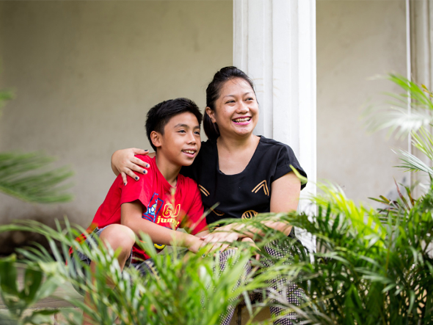
Tips for talking to your teenager
How to support and communicate with your teenager as they take on more T1D responsibilities, plus tips for raising teens with diabetes.
Meet the caregivers who provide support to children with type 1 diabetes
Juvenile (childhood) diabetes is a not uncommon disease among children. The total number of children with type 1 diabetes is estimated to be 1.2 million globally. 1
Type 1 diabetes is thought to occur after the body’s immune system is triggered to destroy cells in the pancreas, which stops your body from being able to produce insulin.2 Insulin is a hormone that helps convert glucose into energy for the body’s cells.3,4 As with adults, the cause of type 1 diabetes in children is still little understood. It is thought that there are genetic characteristics that are inherited and then triggered by environmental factors. 2
Although it has a lower incidence compared with type 1 diabetes, the number of cases of type 2 diabetes in children (youth-onset type 2 diabetes) is rising. As type 2 diabetes is linked with having overweight or living with another chronic disease like obesity, it is thought that poor diets and sedentary lifestyles are behind the increased incidences of type 2 diabetes in children. Other factors may also have an influence, including genes and maternal obesity.2
Symptoms of diabetes in children can often be different to those seen in adults:
As everybody can experience diabetes differently, the symptoms they experience may also be different. If your child is displaying any of these symptoms it is important to discuss them with a healthcare professional. Recognising diabetes symptoms in children can help with early diagnosis and treatment can help prevent long-term complications of diabetes. 5
How a child manages and treats their diabetes will depend on the type of diabetes they have: 5
Children with type 1 diabetes will produce little to no insulin themselves and will therefore need to start on an insulin treatment.
As part of this treatment the child’s blood sugar will need to be regularly measured to help understand the level of control of the diabetes and how much insulin needs to be injected. Small children will only need small doses, but as they continue to grow the amount of insulin they require will also grow.
Following the first diagnosis, a specialist diabetes team will help
on the initiation of treatment, which could include fast-acting
insulin around mealtimes and slow-acting insulin to help control blood
sugar levels throughout the day and overnight. Insulin is normally
given via an injection, insulin pumps and other devices to help manage
their insulin.
Type 2 diabetes in children can be managed in different ways. If they are at an earlier stage, then their blood sugar levels could be controlled through diet and exercise. Some children with type 2 diabetes may go on to need medication to help manage their blood sugars.
For both types of diabetes, as your child grows so will their needs so it is important to have regular visits with their healthcare team so their treatment plan can grow with them.
Managing diabetes in children can be very complicated and there are plenty of things that parents, and carers can do to support children with their diabetes. The amount of involvement and support needed will vary depending on the age of the child. 7
For younger children, a carer may have to be very involved doing everything from delivering insulin to regularly monitoring blood sugar levels. As the child grows the responsibility of the carer, supported by healthcare professionals, will move away from the physical management and be more about teaching the child to manage their own diabetes. Part of this role will include education on diabetes and the importance of controlling blood sugar, as this can improve management of blood sugar levels as well as having positive psychological and social outcomes.
For children of any age, parents and carers should make themselves aware and look out for signs of low blood sugar (known as hypoglycaemia), these include confusion, intense hunger, feeling sick, clumsiness, blurred vision and slurred speech. Carers should also make sure that the child has easy access to suitable food to help raise blood sugar levels should they drop.
Beyond management of any medications parents and carers can help manage their children’s diabetes by ensuring a healthy balanced diet with lots of complex carbohydrates and maintaining good levels of regular exercise.
HQ25DI00016
